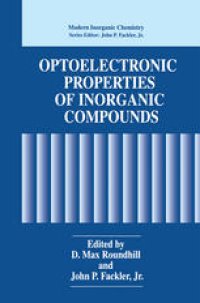
Ebook: Optoelectronic Properties of Inorganic Compounds
- Tags: Optics Optoelectronics Plasmonics and Optical Devices, Electrical Engineering, Characterization and Evaluation of Materials, Inorganic Chemistry, Physical Chemistry
- Series: Modern Inorganic Chemistry
- Year: 1999
- Publisher: Springer US
- Edition: 1
- Language: English
- pdf
This book is intended to offer the reader a snapshot of the field of optoelectronic materials from the viewpoint of inorganic chemists. The field of inorganic chemistry is transforming from one focused on the synthesis of compounds having interesting coordination numbers, structures, and stereochemistries, to one focused on preparing compounds that have potentially useful practical applica tions. Two such applications are in the area of optics and electronics. These are fields where the use of inorganic materials has a long history. As the field of microelectronics develops the demands on the performance of such materials increases, and it becomes necessary to discover compounds that will meet these demands. The field of optoelectronics represents a merging of the two disciplines. Its emergence is a natural one because many of the applications involve both of these properties, and also because the electronic structure of a metal compound that confers novel optical properties is often one that also influences its electron transfer and conductivity characteristics. Two of the more important growth areas that have led to these developments are communications and medicine. Within the communications field there is the microelectronics that is involved in information storage and transmittal, some of which will be transferred into the optical regime. Within the medical field there are chemical probes that transmit analytical information from an in vivo environment. This information needs to be readily accessible from an external site, and then quickly converted into images or data that yield accurate and inexpensive diagnoses.
The involvement of inorganic chemistry in the field of optoelectronics is natural, since the electronic structure of a metal compound that confers novel optical properties is often one that also influences its electron transfer and conductivity characteristics. Two important growth areas for optoelectronics are communications and medicine. The major topics covered in the present book are nonlinear optics of transition meal compounds, inorganic clusters and organometallics, electroluminescence, photovoltaic solar cells, photoluminescence, optical sensors and metallo-organic materials for optical telecommunications. There are also specific chapters on pressure effects on emissive materials and the photophysical and photochemical properties of gold complexes.
This book is intended for faculty, postdoctoral and graduate student level researchers at universities and research scientists at corporations and national laboratories. The book should be of interest to scientists in the fields of Inorganic Chemistry, Materials Science, Photophysics and Solid State Materials. Optoelectronics is a unique, interdisciplinary field that spans many disciplines.
The involvement of inorganic chemistry in the field of optoelectronics is natural, since the electronic structure of a metal compound that confers novel optical properties is often one that also influences its electron transfer and conductivity characteristics. Two important growth areas for optoelectronics are communications and medicine. The major topics covered in the present book are nonlinear optics of transition meal compounds, inorganic clusters and organometallics, electroluminescence, photovoltaic solar cells, photoluminescence, optical sensors and metallo-organic materials for optical telecommunications. There are also specific chapters on pressure effects on emissive materials and the photophysical and photochemical properties of gold complexes.
This book is intended for faculty, postdoctoral and graduate student level researchers at universities and research scientists at corporations and national laboratories. The book should be of interest to scientists in the fields of Inorganic Chemistry, Materials Science, Photophysics and Solid State Materials. Optoelectronics is a unique, interdisciplinary field that spans many disciplines.
Content:
Front Matter....Pages i-xv
Structure-Property Relationships in Transition Metal-Organic Third-Order Nonlinear Optical Materials....Pages 1-27
Electroluminescence in Molecular Materials....Pages 29-54
Nonlinear Optical Properties of Inorganic Clusters....Pages 55-105
Organometallics for Nonlinear Optics....Pages 107-167
Efficient Photovoltaic Solar Cells Based on Dye Sensitization of Nanocrystalline Oxide Films....Pages 169-194
Photophysical and Photochemical Properties of Gold(l) Complexes....Pages 195-229
Pressure Effects on Emissive Materials....Pages 231-268
Photoluminescence of Inorganic Semiconductors for Chemical Sensor Applications....Pages 269-315
Optical Sensors with Metal Ions....Pages 317-347
Metallo-Organic Materials for Optical Telecommunications....Pages 349-406
Back Matter....Pages 407-412
The involvement of inorganic chemistry in the field of optoelectronics is natural, since the electronic structure of a metal compound that confers novel optical properties is often one that also influences its electron transfer and conductivity characteristics. Two important growth areas for optoelectronics are communications and medicine. The major topics covered in the present book are nonlinear optics of transition meal compounds, inorganic clusters and organometallics, electroluminescence, photovoltaic solar cells, photoluminescence, optical sensors and metallo-organic materials for optical telecommunications. There are also specific chapters on pressure effects on emissive materials and the photophysical and photochemical properties of gold complexes.
This book is intended for faculty, postdoctoral and graduate student level researchers at universities and research scientists at corporations and national laboratories. The book should be of interest to scientists in the fields of Inorganic Chemistry, Materials Science, Photophysics and Solid State Materials. Optoelectronics is a unique, interdisciplinary field that spans many disciplines.
Content:
Front Matter....Pages i-xv
Structure-Property Relationships in Transition Metal-Organic Third-Order Nonlinear Optical Materials....Pages 1-27
Electroluminescence in Molecular Materials....Pages 29-54
Nonlinear Optical Properties of Inorganic Clusters....Pages 55-105
Organometallics for Nonlinear Optics....Pages 107-167
Efficient Photovoltaic Solar Cells Based on Dye Sensitization of Nanocrystalline Oxide Films....Pages 169-194
Photophysical and Photochemical Properties of Gold(l) Complexes....Pages 195-229
Pressure Effects on Emissive Materials....Pages 231-268
Photoluminescence of Inorganic Semiconductors for Chemical Sensor Applications....Pages 269-315
Optical Sensors with Metal Ions....Pages 317-347
Metallo-Organic Materials for Optical Telecommunications....Pages 349-406
Back Matter....Pages 407-412
....